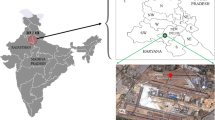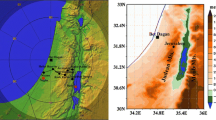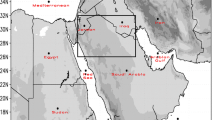Abstract
Six cases of dust storms that occurred over the northwestern and northern parts of India have been studied here to understand the effect of dust on the lightning characteristics of these storms. Satellite pictures show high dust content on all six storm days, and ground station data show that visibility was reduced to less than 500 m. Lightning data observed by the lightning detection network indicate that these six cases of convective dust storms produced more than 30 percent of positive CG lightning in the total CG lighting, which is considered to be very high compared to ordinary thunderstorms. Further, analysis indicates that the current carried by positive lightning is much higher than negative lightning. In some cases, the lightning flash rate reached more than 200 flashes per min (fpm). Observation shows that all these thunderstorms were accompanied by dust, and hence, incursion of the abundance of dust particles into the cloud was likely to be very high. Many earlier observations have suggested that aerosols can affect thunderstorms’ microphysical (such as vertical distribution of the hydrometers) and electrical characteristics. With the abundance of dust particles in the cloud and increased positive CG discharges, it has been proposed that increased dust particles can modify the vertical distribution of ice particles inside a thundercloud and affect the lightning flash rate as well as polarity.















Similar content being viewed by others
References
Andreae MO, Rosenfeld D, Artaxo P, Costa AA, Frank GP, Longo KM, Silva-Dias MAF (2004) Smoking rain clouds over the amazon. Science 303(5662):1337–1342. https://doi.org/10.1126/science.1092779
Avila EA, Pereyra RG (2000) Charge transfer during crystal-graupel collisions for two different cloud droplet size distributions. Geophys Res Lett 27:3837–3840. https://doi.org/10.1029/2000GL012302.issn:0094-8276
Bell TL, Rosenfeld D, Kim KM, Yoo JM, Lee MI, Hahnenberger M (2008) Midweek increase in US summer rain and storm heights suggests air pollution invigorates rainstorms. J Geophys Res Atmos 113(2):1–22. https://doi.org/10.1029/2007JD008623
Biswasharma R, Roy P, Samanta D, Pramanik GP, Sharma S (2021) Regional variation of electrical and lightning properties of thunderclouds during the pre-monsoon season over the north-eastern and eastern part of India. Atmos Res 260:105683. https://doi.org/10.1016/j.atmosres.2021.105683
Blyth AM, Christian HJ, Driscoll K, Gadian AM, Latham J (2001) Determination of ice precipitation rates and thunderstorm anvil ice contents from satellite observations of lightning. Atmos Res 59–60:217–229
Boccipio DJ (2001) Lightning scaling relations revisited. J Atmos Sci 59:1086–1104
Carey LD, Rultlege SA (1996) A multiparameter radar case study of the microphysical & kinametic evoluation of a lightning producing storm. Meteor Atmos Phys 59:33–64
Chandra S, Siingh D, Victor NJ, Kamra AK (2021) Lightning activity over South/Southeast Asia: modulation by thermodynamics of lower atmosphere. Atmos Res 250:105378. https://doi.org/10.1016/j.atmosres.2020.105378,1-10
Choudhury BA, Goswami BN, Zahan Y, Rajes PV (2021) Seasonality in power law scaling of convective and stratiform rainfall with lightning intensity over Indian monsoon regions. Atmos Res 248:105265. https://doi.org/10.1016/j.atmosres.2020.105265
Cummins KL, Williams ER (2017) Inverted polarity thunderstorms linked with elevated cloud base height. AGU Fall Meeting, New Orleans
Dye JE, Ridley BA, Skamarock W, Barth M, Venticinque M, Defer E, Blanchet P, Thery C, Laroche P, Baumann K, Hubler G (2000) An overview of the Stratospheric-Tropospheric Experiment: Radiation, Aerosols, and Ozone (STERAO)-deep convection experiment with results for the July 10, 1996 storm. J Geophys Res Atmos 105(D8):10023–45. https://doi.org/10.1029/1999JD901116
Fernandes WA, Pinto IRCA, Pinto O, Longo KM, Freitas SR (2006) New findings about the influence of smoke from fires on the cloud-to-ground lightning characteristics in the amazon region. Geophys Res Lett 33(20):4–7. https://doi.org/10.1029/2006GL027744
Gautam R, Liu Z, Singh RP, Hsu NC (2009) Two contrasting dust-dominant periods over India observed from MODIS and CALIPSO data. Geophys Res Lett 36(6):1–5. https://doi.org/10.1029/2008GL036967
Ginoux P, Prospero JM, Gill TE, Hsu NC, Zhao M (2012) Global-scale attribution of anthropogenic and natural dust sources and their emission rates based on MODIS deep blue aerosol products. Rev Geophys 50(3):1–36. https://doi.org/10.1029/2012RG000388
Gopalakrishnan V, Pawar SD, Domkawale MA (2020) Charging processes during dissipation stage of thunderstorm. Meteorol Atmos Phys. https://doi.org/10.1007/s00703-020-00755-0
Hankin, EH, (1921) On dust raising winds and descending currents. India Meteorol Memoirs 22, 210e223
Joseph PV, Raipal DK, Deka SN (1980) And, the convective duststorm of northwest India. Mausam 31(431):431–442
Khain A, Cohen N, Lynn B, Pokrovsky A (2008) Possible aerosol effects on lightning activity and structure of hurricanes. J Atmos Sci 65(12):3652–3677
Kohfeld KE, Harrison SP (2001) DIRTMAP: the geological record of dust. Earth Sci Rev 54(1–3):81–114. https://doi.org/10.1016/S0012-8252(01)00042-3
Lal DM, Pawar SD (2009) Relationship between rainfall and lightning over central Indian region in monsoon and premonsoon seasons. Atmos Res 92:402–410
Lang TJ, Miller LJ, Weisman M, Rutledge SA, Barker LJ III, Bringi VN, Chandrasekar V, Detwiler A, Doesken N, Helsdon J, Knight C, Krehbiel P, Lyons WA, MacGorman D, Rasmussen E, Rison W, Rust WD, Thomas R (2004) The severe thunderstorm electrification and precipitation study (STEPS). Bull Am Meteorol Soc 85:1102–1125
Léon JF, Legrand M (2003) Mineral dust sources in the surroundings of the North Indian ocean. Geophys Res Lett. https://doi.org/10.1029/2002GL016690
Lyons WA, Nelson TE, Williams ER, Cramer JA, Turner TR (1998) Enhanced positive cloud-to-ground lightning in thunderstorms ingesting smoke from fires. Science 282(5386):77–80. https://doi.org/10.1126/science.282.5386.77
Mansell, ER, DR MacGorman, CL Ziegler, and JM Straka (2005) Charge structure and lightning sensitivity in a simulated multicell thunderstorm J Geophys Res 110 1029/2004JD005287
Marshall TC, Stolzenburg M, Krehbiel PR, Lund NR, Maggio CR (2009) Electrical evolution during the decay stage of NewMexico thunderstorms. J Geophys Res 114:D02209. https://doi.org/10.1029/2008JD010637
Mudiar D, Pawar SD, Hazra A, Konwar M, Gopalakrishnan V, Srivastava MK, Goswami BN (2018) Quantification of observed electrical effect on the raindrop size distribution in tropical clouds. J Geophys Res Atmos 123(9):4527–4544. https://doi.org/10.1029/2017JD028205
Murray ND, Orville RE, Huffines GR (2000) Effect of pollution from Central American fires on cloud-to-ground lightning in May 1998. Geophys Res Lett 27(15):2249–2252. https://doi.org/10.1029/2000GL011656
Pawar SD, Kamra AK (2009) Maxwell current density characteristics below isolated thunderstorms in tropics. J Geophys Res Atmos 114(4):1–12. https://doi.org/10.1029/2008JD010348
Pawar SD, Gopalakrishnan V, Murugavel P, Veremey NE, Sinkevich AA (2017) Possible role of aerosols in the charge structure of isolated thunderstorms. Atmos Res 183:331–340. https://doi.org/10.1016/j.atmosres.2016.09.016
SD Pawar, AK Kamra, (2004) Evolution of lightning and the possible initiation/triggering of lightning discharges by the lower positive charge centre in an isolated thundercloud in Tropics J Geophys Res
Rosenfeld D (1999) TRMM observed first direct evidence of smoke from forest fires inhibiting rainfall. Geophys Res Lett 26(20):3105–3108. https://doi.org/10.1029/1999GL006066
Rosenfeld D, Woodley WL (2003) Closing the 50-year circle: from cloud seeding to space and back to climate change through precipitation physics cloud systems hurricanes tropical rainfall measuring mission (TRMM). Meteor Monogr 51:59–80
Rosenfeld D, Fromm M, Trentmann J, Luderer G, Andreae MO, Servranckx R (2007) The Chisholm firestorm: observed microstructure, precipitation and lightning activity of a pyro-cumulonimbus. Atmos Chem Phys 7(3):645–659. https://doi.org/10.5194/acp-7-645-2007
Rosenfeld D, Woodley WL, Axisa D, Freud E, Hudson JG, Givati A (2008) Aircraft measurements of the impacts of pollution aerosols on clouds and precipitation over the Sierra Nevada. J Gerontol Ser A Biol Med Sci 113(15):1–23. https://doi.org/10.1029/2007JD009544
Shukla BP, John J, Padmakumari B, Das D, Thirugnanasambantham D, Gairola RM (2022) Did dust intrusion and lofting escalate the catastrophic widespread lightning on 16th April 2019, India? Atmos Res 266:105933. https://doi.org/10.1016/j.atmosres.2021
Ushio T, Heckman SJ, Boccippio DJ, Christian HJ, Kawasaki Z-I (2001) A survey of thunderstorm flash rates compared to cloud top height using TRMM satellite data. J Geophys Res 106(D20):24089–24095
Vonnegut B (1963) Some facts and speculations concerning the origin and role of thunderstorm electricity. Meteorol Monogrs 27:224–241
Williams ER (1985) Large scale charge separation in thunderclouds. J Geophys Res 90:6013–6025. https://doi.org/10.1029/JD090iD04p06013
Williams ER (1989) The tripole structure of thunderstorms. J Geophys Res 94:13151
Williams ER (2001) The electrification of severe storms. Meteorol Monogr 28(50):527–561
Williams ER, Boccippio DJ (1993) Dependence 401 of cloud microphysics and electrification on mesoscale vertical air motion in stratiform precipitation. In: Conference on atmospheric electricity, St. Louis, MO, American Meteorology Society, pp 825–831
Williams E, Rosenfeld D, Madden N, Gerlach J, Gears N, Atkinson L, Dunnemann N, Frostrom G, Antonio M, Biazon B, Camargo R, Franca H, Gomes A, Lima M, Machado R, Manhaes S, Nachtigall L, Piva H, Quintiliano W, Avelino E (2002) Contrasting convective regimes over the amazon: implications for cloud electrification. J Geophys Res Atmos 107(D20):1–19. https://doi.org/10.1029/2001JD000380
Williams E, Mushtak V, Rosenfeld D, Goodman S, Boccippio D (2005) Thermodynamic conditions favorable to superlative thunderstorm updraft, mixed-phase microphysics and lightning flash rate. Atmos Res 76(1–4):288–306. https://doi.org/10.1016/j.atmosres.2004.11.009
Yadav S, Rajamani V (2004) Geochemistry of aerosols of north-western part of India adjoining the Thar desert. Geochim Cosmochim Acta 68(9):1975–1988. https://doi.org/10.1016/j.gca.2003.10.032
Zajac BA, Rutledge SA (2001) Cloud-to-Ground lightning activity in the contiguous United States from 1995 to 1999. Mon Weather Rev 129(5):999–1019. https://doi.org/10.1175/1520-0493(2001)129<0999:CTGLAi>2.0.CO;2
Acknowledgements
IITM is funded by the Ministry of Earth Sciences, Government of India. The authors express their sincere gratitude to the Director of the IITM for his continuous support and encouragement. Thanks to Upper-Air Instruments Division, India Meteorological Department, New Delhi, for providing Radar data. A part of this work was carried out under the DST-BRICS LiESTER project. SDP and VG acknowledge the support received under this DST BRICS Project
Funding
Indian Institute of Tropical Meteorology (IITM) is funded by Ministry of Earth Sciences Govt. of India. This research is not funded by any outside agency.
Author information
Authors and Affiliations
Corresponding author
Ethics declarations
Conflict of interest
None.
Additional information
Publisher's Note
Springer Nature remains neutral with regard to jurisdictional claims in published maps and institutional affiliations.
Rights and permissions
Springer Nature or its licensor holds exclusive rights to this article under a publishing agreement with the author(s) or other rightsholder(s); author self-archiving of the accepted manuscript version of this article is solely governed by the terms of such publishing agreement and applicable law.
About this article
Cite this article
Gangane, A., Pawar, S.D., Gopalakrishnan, V. et al. Effect of dust particles on lightning flash rate and polarity of dust storms over India. Nat Hazards 115, 2505–2529 (2023). https://doi.org/10.1007/s11069-022-05651-x
Received:
Accepted:
Published:
Issue Date:
DOI: https://doi.org/10.1007/s11069-022-05651-x




